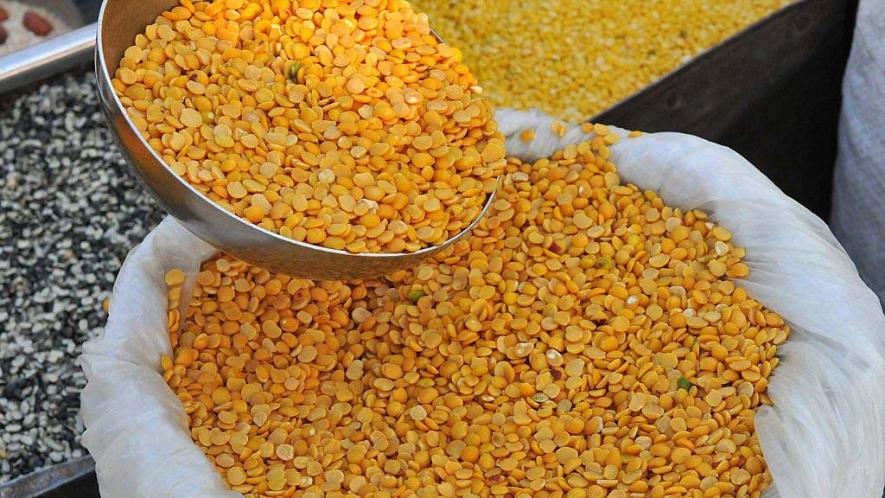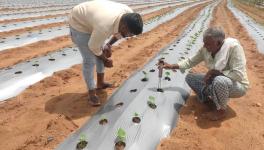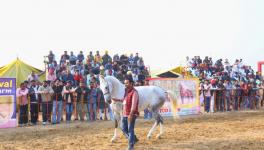Millers Minted Rs 4,600 Crore as Modi Govt Turned Pulses Auction Rule on its Head

The Narendra Modi government’s opaque action rules for pulses allowed millers to earn around Rs 4,600 crore from milling more than 5.4 lakh tonnes of raw dal meant for welfare schemes, including the Pradhan Mantri Garib Kalyan Yojana (PMGKAY), and the defence services.
According to the Reporter’ Collective, a group of journalists, the National Agricultural Cooperative Marketing Federation of India Ltd (NAFED), which selects millers for processing raw pulses for welfare schemes, has been auctioning pulses since 2018 without setting a base rate, or floor, that jump-starts any auction and a fail-safe switch to prevent millers from concealing profit.
According to a Reporters’ Collective report published in the news website The Wire, Right to Information queries revealed that the millers profited at the expense of the government while compromising the quality of the pulses.
In an attempt to undo the damage, which was revealed when states complained to the Centre about the poor quality of processed pulses provided as part of PMGKAY during the lockdown with some even rejecting them, the government has called for a review of the auctions, several government officials told the Reporters’ Collective.
“We have submitted a report to the government recommending how NAFED should procure, store and process the pulses,” Nachiket Kotwaliwale, director, Central Institute of Post-Harvest Engineering & Technology said.
Following the submission of the report, the government was forced to constitute an inter-agency panel to review how millions of tonnes of pulses are procured, stored and milled by NAFED. The Centre has termed the face-saving process as “reforms”. Shockingly, the panel hasn’t finalised its recommendations even as NAFED is again preparing to procure and mill pulses.
CHANGE IN AUCTION METHODOLOGY
When the prices of peas and pulses hit the roof in 2015, NAFED persuaded farmers to produce more pulses by promising to buy up their produce. When stocks piled up, NAFED proposed in 2017 that the government would offer pulses to states under welfare schemes at subsidised and affordable prices.
NAFED and the Modi government decided to get raw pulses milled and delivered to states. Under NAFED’s auction rules, the government finds the lowest possible price at which a bidder is ready to process pulses based on milling charges. For example, if the government wants 100 kg of Urad milled into 70 kg of processed dal, the potential millers would calculate the costs of de-husking, splitting and polishing the pulses, packing and transporting the processed daal. They would factor in the revenue from selling the by-products add their profit and quote a price—and the lowest bidder will be the winner.
However, NAFED turned the auction process on its head by not asking a bidder to quote the lowest possible price to mill pulses and deliver to designated places. Instead, the miller quoted the highest possible out-turn ratio (OTR), the ratio between the quantity of final good he churns out and the quantity of raw commodity they get. Therefore, the miller who offered the highest quantity of finished pulses, or highest OTR, from raw stock won.
The millers filled their coffers since the auctions didn’t have a ‘floor’, or lower limit, on the OTR they bid. A mere 1% change in this ratio can set the government back by hundreds of crores against bills raised by millers.
A base rate was put in place by states as a safeguard against cartelisation and undervaluation. For example, a tender to process chickpeas floated on August 19, 2020, by the Andhra Pradesh State Civil Supplies Corporation set the floor OTR at 70%, capping the maximum profits the millers could make from the contract.
More shocking was NAFED going ahead with the new auction rule despite the Comptroller and Auditor General (CAG) finding in 2015 that low OTR allowed rice millers to retain excess rice, causing around Rs 2,000 crore loss to the exchequer. The CAG noticed the problem after the Indian Institute of Crop Processing Technology showed that rice varieties grown in the area have an average OTR much higher than the ones accepted by the Andhra Pradesh government.
The auction methodology was also brought before the Central Vigilance Commission in 2020 alleging that the auctions caused more than Rs 1,000 crore loss and demanding a thorough audit.
HOW THE MILLERS PROFITED
Due to no base rate, the millers quoted an OTR lower than what they would be able to get from a particular grade of pulses. The excess pulse was sold along with the by-products in the open market to make a profit. Moreover, both NAFED and the government were clueless about the market rates at which the millers sold the excess quantity of processed pulses and the total profit they made on every tender.
An analysis of the auction by the Reporters’ Collective found that the approved OTR for pigeon peas meant to be distributed under PMGKAY was nearly 8 percentage points lower at 61% than the floor values set by Tamil Nadu in 2018.
Documents revealed that the Department of Consumer Affairs overruled the Department of Expenditure’s recommendation of calculating the cost of milling and supplying pulses under PMGKAY on the basis of OTR, preventing real assessment of whether approved OTRs were viable.
“The cost involved in transportation from warehouse to mill point, loading, unloading, processing, packing and further transportation to the delivery points varies in each of the auctions as the locations of warehouses and delivery points are different. It is, therefore, not possible to put any floor values and conversion templates before conducting the auctions,” NAFED told the Reporters’ Collective when asked why no base rate was set.
“Moreover, the objective of the OTR-based auction was to convert the raw pulses into milled pulses without paying any extra amount on account of all additional cost incurred during the supply of milled pulses to the delivery depots of the states,” Nafed said. “NAFED had chosen to conduct auctions based on OTRs as per the modalities approved by the Department of Consumer Affairs with a view to complete supplies of pulses to the needy one in the shortest time possible.”
However, auction archives showed that OTR auctions were held years before COVID-19 hit India. A Delhi High Court order shielding NAFED from RTI queries prevents accessing the data on how it decides the winning OTR value in these auctions.
The changed auction methodology allowed the millers to supply pulses from the open market to the poor and keep the government-procured stock of the same quantity for their own commercial use. The millers avoided paying the heft deposit required to take stock from NAFED, process and then deliver.
A miller who participated in the PMGKAY auctions said, “Mostly, supply under these auctions was by dispatching stock from the local market and lifting NAFED’s raw material after delivery. Lifting stock and then processing it for delivery would involve a large bank guarantee.”
A senior industry official requesting anonymity said that NAFED “doesn’t really care if the daal supplied is from the chana they procured. They only want delivery of a particular specification made to the location”.
NAFED’s logic that the new auction rules were aimed at speeding up distribution to make up for the damage caused to supply chain and logistics during the pandemic is flawed since the methodology was introduced way back in 2018. “… it was the need of the hour to supply pulses to the needy in time. Had this been not done, NAFED could not have ensured timely supplies. NAFED has successfully completed the supply across India in the shortest time possible,” the federation said.
NAFED was unwilling to answer how it ensures the pulses the millers deliver is of the same quality they pick up from it. “NAFED purchases stock of pulses under PSS (price support scheme) confirming to FAQ (fair average quality) specifications. The stock is subsequently transferred to maintain a buffer of pulses. It may be concluded that the stock of pulses lying in the buffer are all of the same quality…”
Get the latest reports & analysis with people's perspective on Protests, movements & deep analytical videos, discussions of the current affairs in your Telegram app. Subscribe to NewsClick's Telegram channel & get Real-Time updates on stories, as they get published on our website.
























